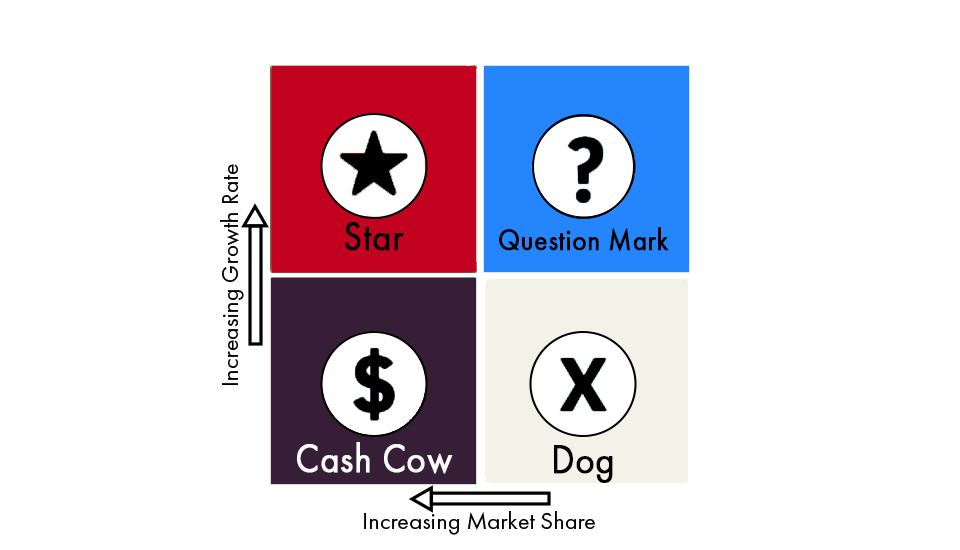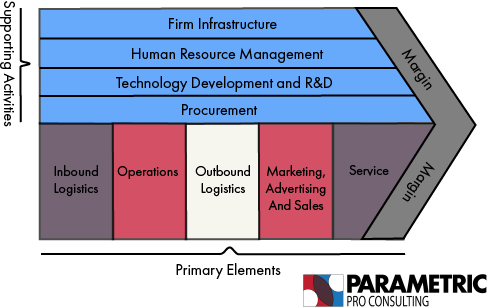What is a Framework?
Have you ever worked on developing business strategies, and struggled to find a jumping-off point? At Parametric Pro, we believe you can avoid this by using frameworks. Frameworks are essentially your “treasure map” to developing competitive strategies.
Business owners and managers can benefit from frameworks regardless of what industry they operate in. Some frameworks work better in certain areas than others, and while each one may not be applicable to every situation, there are often multiple frameworks that you can use when working on any type of problem.
In this post, we’ll provide 11 different business frameworks (in no particular order) that you can use to help streamline your decision-making process and bolster your strategic thinking.
Why are Frameworks Important?
Frameworks are useful tools that you can use to develop a blueprint for success by ensuring you stay focused and on track when making decisions. Some frameworks are MECE (mutually exclusive & collectively exhaustive) to help you avoid “running in circles” when navigating problems by making sure you consider all relevant factors in a way that keeps variables from influencing each other too much.
Along with these benefits, frameworks give you a way to clearly communicate your thought process to whoever is affected by your decision, be that investors, staff, or other owners.
11 Business Strategy Frameworks
PORTER’S 5 FORCES
You’ve probably heard of this classic framework developed by Harvard professor Michael E. Porter in 1979, and for great reason! This framework remains relevant today and is widely used by consultants and business managers all over the world. Porter’s 5 Forces include Rivalry, Suppliers, Substitutes, Buyers, and New Entrants. You can use this framework to analyze your company’s competitive environment by looking at your rivals, potential new market entrants, customers, suppliers, and possible substitute products or services that could take market share from you. Porter’s 5 Forces can help you boost your profits, but you must continuously check for any changes in the forces to adjust your strategy accordingly.
VALUE NET FRAMEWORK
The Value Net framework is a modified version of Porter’s 5 Forces, written by Adam M. Brandenburger and Barry J. Nalebuff in 1996 to apply Game Theory and business strategy. Porter’s 5 Forces doesn’t account for competition working together to reach larger and higher valued markets than what would be possible individually. The Value Net framework includes the forces of Customers, Suppliers, Substitutes (Competitors), and your Company at the center. You can apply this framework to your business to assess opportunities for cooperation with any of the forces, even your competition. It’s also important to note that one company can take up the roles of multiple forces (e.g., a company can act as both a Supplier and a Substitute). When using the Value Net framework, you have to be careful because it is not a MECE framework and can lead to circular thinking.
PROFIT FRAMEWORK
You probably already know what profit is, revenue minus expenses. The profit framework can be a useful starting point when you want to analyze your revenues and expenses. By using the framework, you can start breaking down your revenue generation to a granular level to better assess your profitability. One way to use this is to break out your costs into two categories – fixed and variable – and then analyze your profit at different levels of sales volume. Then, you can go on to see what is costing you the most, and if you need to make any adjustments to manufacturing, office space, or anything else.
CONGRUENCE FRAMEWORK
The Congruence framework is great for ensuring that your company is acting in alignment with its proclaimed values. You can use this framework to check if the internal structures and systems are set up to support the strategy and values of your company. The individual jobs, roles, and responsibilities of everyone at your company should all have clear definitions and descriptions that are in Congruence with the mantra of your company. Ideally, the tasks, people, and structures within your company’s operations should all be aligned towards the same values. When this holds true, your corporate strategy can be strengthened in a way that is otherwise impossible. Additionally, you can boost the morale at all levels of your company by ensuring that your stakeholders (employees, investors, and management) are aligned in their goals and vision for the company.
BCG GROWTH-SHARE MATRIX
Depending on your background, you may have heard of the Boston Consulting Group’s Growth Share Matrix – created in 1968 by BCG’s founder, Bruce Henderson. Traditionally, the Growth Share Matrix is used in portfolio management to help companies make decisions about what to do with their businesses. The Matrix is divided into 4 boxes representing a Star, a Question Mark, a Cash Cow, and a Dog. Businesses are then sorted into these boxes based on the combination of their relative market share and their growth rate. You can use this to see where you are in relation to competitors or use the matrix to analyze the divisions of your own business to better focus resources for value generation. In extreme cases, this framework can also help you solidify the decision to shut down certain operations to cut your losses.

ZERO-BASED BUDGETING
Zero-Based Budgeting (ZBB) is a form of budgeting that will reduce your costs by scrutinizing every expense that your company takes on. To use ZBB effectively, you want to review all your expenses at a specific interval such as quarterly, bi-quarterly, at the end of each fiscal year, etc. This process involves you starting from a $0 budget, then analyzing and justifying each operation and expense to determine if they are necessary. After figuring out exactly what expenses you can justify, you’ll go on to create a budget around those expenses regardless of the last budget that was in place. The idea here is that by not working off of an old budget, you’re able to remove bloat every single time you perform a ZBB analysis. This is because ZBB accounts for old and new expenses alike, while traditional budgeting only accounts for new expenses.
GAME THEORY
Game Theory is a theoretical framework that is a foundational belief here at Parametric Pro. The idea behind Game Theory is that all parties involved in a situation are rational, will work to maximize their individual payoffs, and that the outcome of each party depends on all other parties’ actions. You can use Game Theory to achieve optimal results for yourself as well as other involved parties by promoting cooperation. Because Game Theory gets around the idea of a “Zero-Sum” game in which parties are directly opposed, you’ll be able to approach situations in a new way. Traditionally, you’ve most likely thought of problems as an exercise in “slicing the pie”, where the goal is to maximize the size of your piece of pie. With Game Theory, you can look at these same problems as an exercise in “growing the pie” so that all parties can prosper.
SWOT ANALYSIS
Much like the BCG Matrix, you’ve probably heard of or used a SWOT Analysis at some point. You can use the SWOT framework to analyze your company’s current situation before making a strategy decision. SWOT stands for Strengths, Weaknesses, Opportunities, and Threats, and assesses these 4 elements of your company by laying them out over four quadrants. Strengths are internal resources that you can benefit from, Weaknesses are internal areas that you may be lacking in, Opportunities are external circumstances that you can benefit from, and Threats are external, well, threats to your business. To effectively use a SWOT framework, we suggest that you gather a team from a variety of departments in your company and start brainstorming ideas for each quadrant before formulating strategic decisions. The SWOT Analysis is very versatile and can be used not only to develop a successful business strategy, but also to develop your marketing plan.
PESTLE ANALYSIS
Another very famous acronym, the PESTLE (or PEST) analysis is a framework to track the environment that your company is operating in or are planning to operate in. PESTLE addresses the Political, Economic, Social, Technological, Legal, and Environmental landscapes that your business is navigating, giving you an overview of the big picture while you make decisions. To effectively use this framework, you need to ensure that you’re asking questions based on each letter of the framework. By analyzing the business environment that you’re operating in, you can identify potential opportunities and threats to look out for. By identifying potential opportunities and then positioning yourself to take advantage of them, you have the potential to create a massive competitive advantage in your market.
SUPPLY CHAIN + VALUE CHAIN FRAMEWORKS
The Supply Chain and Value Chain frameworks are essential parts of your toolkit as a businessperson. You can use the Supply Chain to track the flow of goods, information, and money related to a product from raw materials to the final product being delivered to the consumer. Supply Chains generally consist of multiple processing points that each add value to the final offering. You can map out where value is added by using the Value Chain, which is a road map of the actions taken at each processing point in the Supply Chain to add value. You’ll be able to maximize your profit by maximizing the value you add at your stage in someone else’s Value Chain and minimizing non-value-adding activities in your Value Chain.

MCKINSEY 7-S FRAMEWORK
Introduced in the 1970s, you may or may not be familiar with McKinsey’s 7-S framework. You can use this framework in a variety of situations to gain insight on how the various parts of your company interact. By identifying how these parts work together, you can improve the overall efficiency and performance of your company, or determine the effects and strategies involved with making organizational changes. You can also apply this model to specific elements of a smaller team or project to align departments or processes.
So, what is the 7-S model? When using this framework, you will look at 7 different Ss:
Strategy – Your plan for creating a competitive advantage in the market.
Structure – The way your company is organized, including the reporting hierarchy and departmental organization.
Systems – The routine actions that your staff use to do their jobs.
Skills – The undeniable competencies of your company’s employees
Shared Values – The core values of your company, shown in the general working attitude and culture.
Style – Your chosen style of leadership
Staff – The actual employees and their general capabilities.
Strategy, Structure, and Systems are considered “hard” elements that you can influence directly. The other four elements are considered “soft”, and they are less tangible than the hard elements. These soft elements are generally influenced by your company’s culture, and they can have massive effects on your organization’s success.
Conclusion
Whether you’re working on completing business objectives, improving your market position, or developing a competitive strategy, frameworks can set you up with an easy-to-follow strategic thought process. Not every framework will fit every situation, but they can be an amazing starting point for approaching problems from a different angle. You’ll probably come up against several problems during your career, so bookmark this post as a quick reference guide to some of our favorite frameworks.
If you liked this post, please consider sharing it with your network!
Be sure to check out the Marketing Strategy Starter Kit!
Want to learn more and see how we can help your business? Book a free consultation call.
Are you interested in the consulting industry? Parametric Pro Consulting Foundations offers more in-depth knowledge on this article as well as several other topics to prepare you for a career in business and consulting. Check it out here!
